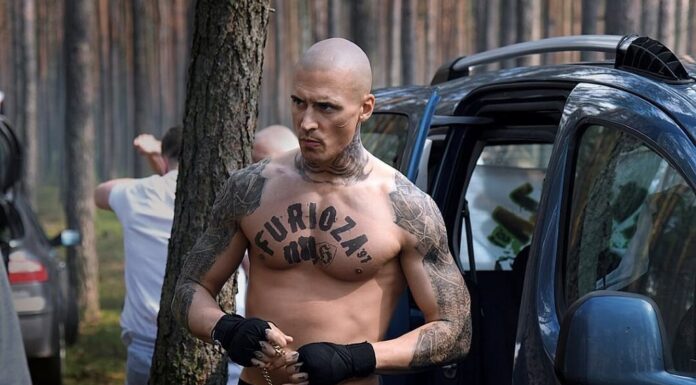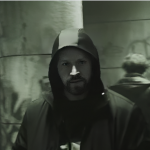Furioza is the most recent Netflix action film, which translates to “Furious” in English. It is a gritty Polish action film that was released on Netflix on April 6, 2022, and has an approximate runtime of 80 minutes. It is a gangster thriller film with a lot action which is directed by Cyprian T. Olencki and starring Mateusz Banasiuk, Weronika Ksiazkiewicz, Mateusz Damiecki, Lukasz Simlat, Wojciech Zielinski, Szymon Bobrowski, Janusz Chabior, and Sebastian Stankiewicz. Furioza is very clear and strongly outlined characters that build the film’s emotionality.
The film examines the football hooligans in Gdynia through the perspective of an outsider. Dawid is the story’s protagonist, and Kaszub is the gang boss. Dawid joins the group after being asked by his old love, while also working as a police informant. As betrayal, lies, secrecy, and rivalry start to grow, the story gets darker and bloodier. Following its release, the movie was well-received by fans and critics because it had a great cast and a great production value. One concept is bothering the fans after watching this film. Is the story true? Is this Furioza movie based on real life? Is it a real gang? Continue reading to learn more about the movie.
Is Furioza based on a true story? Furioza: Is It A Real Gang?
First and Foremost, ‘Furioza’ Polish film about hooligans inspired by real events. According to the press release, Furioza is a film based on true events that depict a world that most of us are unaware of. Ultras, hooligans, and women in relationships with them make up the world of fans. Cyprian T. Olencki and Tomasz Klimala are responsible for the script for “Furioza”. The script took several years to write, and the plot is based on true events and depicts the secrets that control the worlds of criminals, football fanatics, and the ladies who live with them. Journalists’, hooligans’, and Central Police Investigation Bureau agents’ reports proved to be invaluable in developing the tale. They prepared for these roles for weeks. Mateusz Damięcki’s rigorous diet and exhausting workouts, Weronika Książkiewicz’s short haircut and a completely new incarnation of Mateusz Banasiuk. Plus, an impressive physical form and electrifying tattoos. ”
The film is about the titular group of football hooligans. Football hooliganism is a form of civil disobedience in which people act violently or belligerently at football games. Football hooliganism usually happens when gangs, which are called football firms. The writers may have been inspired by real-life examples of football hooliganism in Poland and its purported ties to the country’s criminal underworld while writing the script.
Do football hooligans still exist?
Football hooliganism has been a hot topic in the country for quite some time. Even though there are still reports of British football hooliganism, the incidents now happen in places other than at the games. Although the exact date of the first occurrence of violence associated with modern team sports is unknown, football-related violence can be traced back to 14th-century England. Edward II prohibited football in 1314 because he feared that the chaos surrounding matches might cause social unrest or even treason. The first documented cases of football hooliganism in the contemporary game are said to have occurred in England in the 1880s when groups of fans terrorized communities as well as attacking referees, opposition fans, and players. Hooliganism in Poland is equivalent to hooliganism in England. Many Polish football clubs have ties to hooligan organizations.
The first reports of supporters fighting at football games dating back to the 1930s. The police were forced to “intervene and surround the field” following a game between Cracovia and Ruch Chorzów on June 2, 1935. The administration of lsk witochowice issued an appeal to its fans on June 15, 1936. During the Nazi German occupation of Poland during World War II, all sports were outlawed.
Over the next few decades, as the number of “scarfers” (hardcore Polish football fans) and fan clubs grew, rare riots erupted among football fans. The number of hooligan firms and hooligans increased in the early 1980s. Legia Warsaw faced Lech Pozna in the Polish Cup final at Czstochowa on May 9, 1980. Legia was victorious in the match. Many people remember it as one of the most heated fan fights ever. A number of people were critically hurt as a result of the accident. All information surrounding the tragedy were kept hidden by Poland’s communist government. Both sides’ fans have regarded each other as foes since that contest. Despite the lack of data evidence, there were as many as 99 instances of civil unrest during football games between 1984 and 1988. Since then, hooligan organizations in Poland have formed and are frequently influenced by the skinhead subculture. known as “official hooligans,” and their role is to participate in stadium disruptions.
The number of hooligan firms increased to around 70 or 80 in the 1990s. The 1990s saw a gradual escalation in football-related violence in Poland, as well as the emergence of a football hooligan subculture. On May 29, 1993, during a World Cup qualifying match between Poland and England, a skinhead member of the K. S. Cracovia fighting team stabbed a Pogo Szczecin supporter to death, exacerbating the situation. After his death, hooliganism spread to minor leagues and urban areas, attracting outraged fans. Other hooligan gangs, such as Moda Arka and Jude Gang, sprung up as the violence intensified. According to data from the Komenda Gówna Policji (Police Central Command), there was a constant growth from 1991 to 1997, but then a reduction in the following years. With only a few businesses remaining, the most well-known is “The Soul Crew,” the firm of Cardiff City FC, the Welsh football club with the most fan bans in the English leagues.
In the twelve months between 2005 and 2006, eight individuals died in situations related to football hooliganism. As the twenty-first century progressed, fans were detained and stadiums were modernized, pushing hooligan gangs to go underground. Legia Warsaw fans attacked visiting Jagiellonia Biaystok fans in March 2014, in the first incident inside a top-level stadium in years, after Legia fans showed many previously stolen Jagiellonia flags. The game was called off. Several people were detained. After a match against Widzew ód in 2014, Zawisza Bydgoszcz fans began to boycott games. Spectators report that police severely beat followers, including women, the elderly, and children, when stopping Zawisza and KS ód fans from entering the stadium, causing one fan to lose an eye.
On May 2, 2015, at a fifth-division match between Concordia Knurów and Ruch Radzionków in Knurów, Upper Silesia, police began firing rubber bullets at fans. Dawid Dziedzic, a 27-year-old Concordia fan, was shot and resuscitated, but he died in hospital hours later. He was a single father from a low-income family who was described as a kind parent. Rioting erupted in the aftermath, which lasted many days. Dawid’s burial was attended by thousands of people on May 7, 2015. As a result, while the plot of the film is fictional, it is based on a very genuine foundation.




![“FBI” Season 6 Episode 13 – Season Finale [Preview] FBI 6x07 Promo](https://www.tvacute.com/wp-content/uploads/2024/03/FBI-6x07-Promo-_Behind-The-Veil_-HD-0-14-screenshot-compressed-150x150.jpg)


